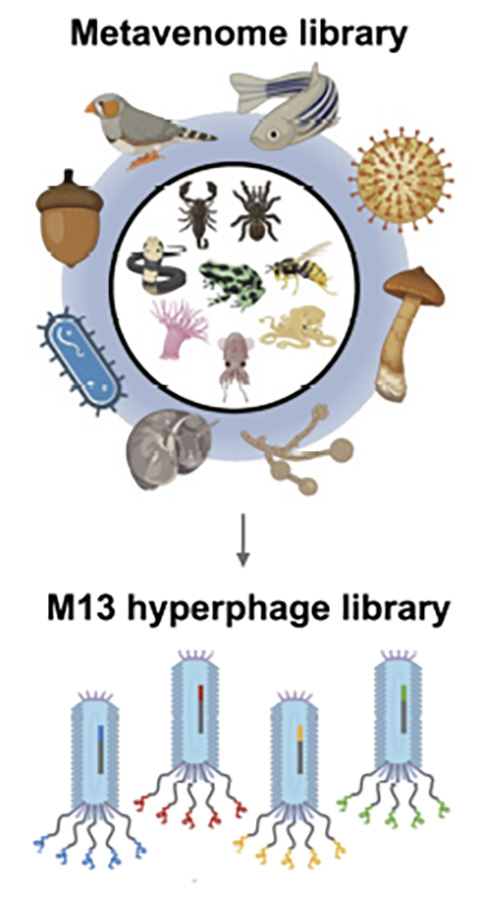Innovative platform empowers scientists to transform venoms into therapeutics
Some of the most successful and effective drugs, like Ozempic, come from animal venoms. However, scientists usually only discover the therapeutic potential of venoms by chance. Recently, an international group of researchers, led by Meng-Hsuan Hsiao of Ben Larman ’s laboratory at Johns Hopkins University, set out to change that by developing a workflow to accelerate drug discovery from peptides, or short sequences of amino acids, with sequences and structures that resemble animal venoms. They published their study in Molecular & Cellular Proteomics.

Hsiao and colleagues demonstrated that their platform could evaluate over 10,000 venom-like peptides’ ability to bind specific receptors on human cells. Larman’s group teamed up with Martin Steinegger, an assistant professor at Seoul National University, who built a “metavenome library” from known animal venom sequences and additional peptides based on sequence homology.
“A library allows us to explore a much larger space of possible lead compounds for drugs,” Larman said. “You don’t even need to have a starting hypothesis.”
The researchers expressed peptides from this library on the surface of bacteriophages, or bacteria-infecting viruses, a technique also known as phage display. For their platform, Larman’s team used what he called a specific “flavor” of phage: the M13 hyperphage.
Hyperphages carry genetic mutations that make them display five copies of venom-like peptides on their surface. Therefore, the displayed peptides could interact with multiple receptors, amplifying the signal and allowing the researchers to detect weaker interactions.
“The way we used hyperphages to display venoms has never been done before,” said Larman.
Unlike other phages, M13 phages are secreted through the bacterial periplasm, the space between the bacteria’s inner and outer cell membranes. The periplasm has an oxidizing chemical environment, Larman explained, and this helps preserve the venom peptides’ disulfide bonds, which are critical for their 3D structures. These disulfide bonds make venoms attractive therapeutics because they are highly compact and resistant to degradation.
Using their platform, Larman’s team identified six proteins in the metavenome library that bind and activate the human itch receptor MAS-related G protein-coupled receptor X4, or MRGPRX4. They found that these proteins share a unique folding pattern called the Kunitz domain, which is commonly known to inhibit serine protease activity. In the future, Larman’s team plans to expand their metavenome library to include even more peptides in search of a potent MRGPRX4 antagonist that can be developed into an anti-itch drug.
“I think that if you can find an agonist, you can also find an antagonist,” Larman said, “And we can likely achieve this by expanding our library.”
Larman said he hopes to integrate generative artificial intelligence into their system to broaden the library to include novel venom-like peptides.
“Once set up and integrated,” he said. “I can see this cycle of computational prediction and experimental validation being really powerful in drug discovery.”
Enjoy reading ASBMB Today?
Become a member to receive the print edition four times a year and the digital edition monthly.
Learn moreGet the latest from ASBMB Today
Enter your email address, and we’ll send you a weekly email with recent articles, interviews and more.
Latest in Science
Science highlights or most popular articles

Mapping fentanyl’s cellular footprint
Using a new imaging method, researchers at State University of New York at Buffalo traced fentanyl’s effects inside brain immune cells, revealing how the drug alters lipid droplets, pointing to new paths for addiction diagnostics.

Designing life’s building blocks with AI
Tanja Kortemme, a professor at the University of California, San Francisco, will discuss her research using computational biology to engineer proteins at the 2026 ASBMB Annual Meeting.

Cholesterol as a novel biomarker for Fragile X syndrome
Researchers in Quebec identified lower levels of a brain cholesterol metabolite, 24-hydroxycholesterol, in patients with fragile X syndrome, a finding that could provide a simple blood-based biomarker for understanding and managing the condition.

How lipid metabolism shapes sperm development
Researchers at Hokkaido University identify the enzyme behind a key lipid in sperm development. The findings reveal how seminolipids shape sperm formation and may inform future diagnostics and treatments for male infertility.

Mass spec method captures proteins in native membranes
Yale scientists developed a mass spec protocol that keeps proteins in their native environment, detects intact protein complexes and tracks drug binding, offering a clearer view of membrane biology.

Laser-assisted cryoEM method preserves protein structure
University of Wisconsin–Madison researchers devised a method that prevents protein compaction during cryoEM prep, restoring natural structure for mass spec studies. The approach could expand high-resolution imaging to more complex protein systems.

